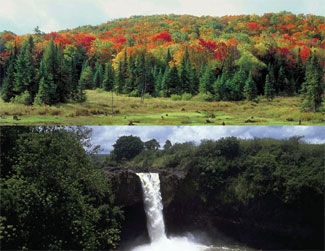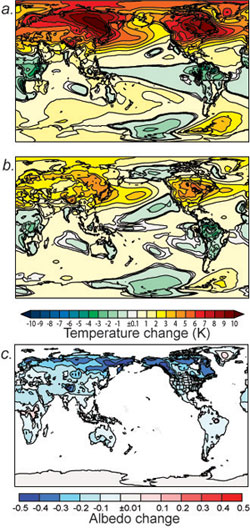Temperate forests may worsen global warming, tropical forests fight higher temperatures
Rhett A. Butler, mongabay.com
December 5, 2005
At this week’s climate conference in Montreal there have been a number of proposals to plant trees for the purpose of absorbing carbon emissions and helping mitigate climate change. However, a new study from the Carnegie Institution’s Department of Global Ecology and Lawrence Livermore National Laboratory says that careful consideration should be given as to where these forests are planted. Planting trees in temperate regions could actually contribute to global warming.
The study, using complex climate modeling software to simulate changes in forest cover and then measuring the impact on global climate, found that northern forests tend to warm the Earth because they absorb a lot of sunlight without losing much moisture. The situation is different in the tropics where higher temperatures result in higher rates of evapotranspiration, the process by which forests release water into the atmosphere. Tropical forests may have a net cooling impact relative to northern forests.
The research has important implications for the greenhouse gas debate. The United States wants any future agreement on climate to include provisions for tradable carbon credits whereby industrial countries could exceed emissions limits by planting forests and exchanging carbon allotments with forested countries. These new findings suggest that reforestation programs should focus on planting trees in the tropics and not in temperate or boreal regions.
Papua New Guinea has made just such a proposal at the UN conference. The plan calls for wealthy countries to pay developing countries to preserve their rainforests arguing that these ecosystems store massive amounts of carbon dioxide as well as providing important ecological services and serving as a repository for most of the planet’s biodiversity.
Below are new releases from the Carnegie Institution and the Lawrence Livermore National Laboratory announcing the research.
Study: Temperate Forests Could Worsen Global Warming
Carnegie Institution news release
December 5, 2005
The researchers used complex climate modeling software to simulate changes in forest cover and then examined the effects on global climate. Their results were surprising. “We were hoping to find that growing forests in the United States would help slow global warming,” Caldeira said. “But if we are not careful, growing forests could make global warming even worse.”
The researchers found that while tropical forests help keep Earth cool by evaporating a great deal of water, northern forests tend to warm the Earth because they absorb a lot of sunlight without losing much moisture. In one simulation, the researchers covered much of the northern hemisphere (above 20° latitude) with forests and saw a jump in surface air temperature of more than 6° F. Covering the entire planet’s land mass with trees led to a more modest increase of about 2° F.
 New climate modeling research from the Carnegie Institution and Lawrence Livermore National Laboratory shows that northern temperate forests (top) may contribute to global warming, while tropical forests (bottom) can help keep global temperatures cool. |
When the scientists restricted the simulation to middle latitudes such as the continental United States, the picture was not quite so clear. At first, cooling due to the uptake of carbon dioxide would offset warming from sunlight absorption. But after several decades, carbon dioxide would begin diffusing from the ocean into the atmosphere, diminishing the cooling effect and warming the Earth in the long term.
Caldeira warns against planting forests on abandoned croplands as a strategy to combat global warming, which some have recommended. But he also recognizes the importance of forests.
“I like forests. They provide good habitats for plants and animals, and tropical forests are good for climate, so we should be particularly careful to preserve them,” Caldeira commented. “But in terms of climate change, we should focus our efforts on things that can really make a difference, like improving efficiency and developing new sources of clean energy.”
The study, authored by Seran Gibbard,* Ken Caldeira, Govindasamy Bala,* Thomas J. Phillips,* and Michael Wickett,* will be published online under the title “Climate effects of global land cover change” in the journal Geophysical Research Letters on December 8, 2005.
*Authors marked with an asterisk are affiliated with Lawrence Livermore National Laboratory.
Carnegie’s Department of Global Ecology was founded in 2002 on the campus of Stanford University. Its staff conducts basic research on the interactions among Earth’s ecosystems, land, atmosphere, and oceans to understand how these interactions shape the behavior of the Earth system, including its response to future change.
The Carnegie Institution of Washington
has been a pioneering force in basic scientific research since 1902. It is a private, nonprofit organization with six research departments throughout the U.S. Carnegie scientists are leaders in plant biology, developmental biology, astronomy, materials science, global ecology, and Earth and planetary science.
Growing more forests in United States could contribute to global warming
Lawrence Livermore National Laboratory
6-Dec-2005
Planting trees across the United States and Europe to absorb some of the carbon dioxide emitted by the burning of fossil fuels may just outweigh the positive effects of sequestering that CO².
In theory, growing a forest may sound like a good idea to fight global warming, but in temperate regions, such as the United States, those trees also would soak up sunlight, causing the earth’s surface to warm regionally by up to 8 degrees Fahrenheit.
 Panel a: Direct warming associated with global forest cover.Panel b:Direct warming associated with forest cover between between 20°N and 50°N. Panel c: Increase in fractional absorption of solar radiation at the ground for forests relative to bare ground. |
Forests affect climate in three different ways: they absorb the greenhouse gas, carbon dioxide, and help to keep the planet cool; they evaporate water to the atmosphere, which also helps keep the planet cool; and they are dark and absorb a lot of sunlight, warming the Earth.
Using climate models, researchers from the Lawrence Livermore National Laboratory and the Carnegie Institution Department of Global Ecology have found that forests in the mid-latitude regions of the Earth, present a more complicated picture. Trees in these areas tend to warm the Earth in the long run. The darkness of these forests absorbs abundant sunlight, warming the land. While the darkness of the forest lasts forever, the effect of the forest sequestering carbon dioxide slows down over time as the atmosphere exchanges CO² with the ocean.
The conclusion: Planting a forest in the United States could cool the Earth for a few decades, but would lead to planetary warming in the long term. These are the results of a study that will be presented at 8:30 a.m. Wednesday, Dec. 7, at the American Geophysical Union Fall Meeting in San Francisco.
“On time scales longer than a few centuries, the net effect will actually be warming in these regions,” said Govindasamy Bala of the Livermore team. “We thought planting trees across the northern hemisphere would help curb global warming by the CO² absorption but what we found was a different story.”
The authors discovered that a global replacement of current vegetation by trees would lead to a global warming of 2.4 degrees Fahrenheit. Global replacement with grassland led to cooling of about 0.7 degrees Fahrenheit
The researchers also found that planting trees between 30-50 degrees latitude worldwide saw the global mean surface air temperature increase by 0.7 degrees Fahrenheit. Regional warming in North America and Eurasia was as high as 8 degrees Fahrenheit. In earlier studies, planting trees in the boreal forest regions (found mostly in the upper half of the Northern Hemisphere) caused a warming of surface temperatures.
“Although it was previously known that trees could have an overall warming effect in the boreal forests (north of 50 degrees), this is the first study to show that temperate forests could lead to net global warming,” said Livermore’s Seran Gibbard, lead author.
The story is different for the tropical forests. In tropical regions, forests help keep the Earth cool by not only absorbing carbon dioxide, but by evaporating plenty of water as well.
“Should we give carbon credit to the planting of forests? Probably not for countries in mid- and high latitudes,” Bala said. “But the tropical forests present a win-win because they cool the planet by evaporative cooling and the uptake of carbon.”
Co-author Ken Caldeira of the Carnegie Institution warns that proposals to grow more forests to cool the planet should be greeted with caution.
“I like forests. They provide good habitats for plants and animals, and tropical forest are good for climate, so we should be particularly careful to preserve them,” he said. But in terms of climate change, we should focus our efforts on things that can really make a difference, like energy efficiency and developing new sources of clean energy.”
The research, also authored by Thomas Phillips and Michael Wickett of Lawrence Livermore, will appear online in the Dec. 8 issue of the journal Geophysical Research Letters.
Founded in 1952, Lawrence Livermore National Laboratory is a national security laboratory, with a mission to ensure national security and apply science and technology to the important issues of our time. Lawrence Livermore National Laboratory is managed by the University of California for the U.S. Department of Energy’s National Nuclear Security Administration.
Related articles
U.S. “exporting” carbon emissions to China says study
12/01/2005 | National Center for Atmospheric Research
The growth of Chinese imports in the U.S. economy boosted the total emissions of carbon dioxide (a primary greenhouse gas) from the two countries by over 700 million metric tons between 1997 and 2003, according to a study published online in the journal Energy Policy. The analysis, prepared by two scientists at the National Center for Atmospheric Research, suggests that American emissions of carbon dioxide in 2003 would have been 6% higher if the United States had manufactured the products that it imported from China. Meanwhile, China’s 2003 emissions would have been 14% lower had it not produced goods for the United States.
Rainforests worth $1.1 trillion for carbon alone in Coalition nations
11/29/2005 | Mongabay.com
If a coalition of developing countries has its way, there could soon be new forests sprouting up in tropical regions. The group of ten countries, led by Papua New Guinea, has proposed that wealthy countries pay them to preserve their rainforests. The Coalition for Rainforest Nations argues that all countries should pay for the benefits — from carbon sequestration to watershed protection — that tropical rainforests provide.
Developing countries: pay us to save rainforests
11/27/2005 | Mongabay.com
At this week’s United Nations summit on climate change in Montreal a coalition of tropical developing countries plans to propose that wealthy countries pay them to preserve their rainforests. The group of 10 countries, led by Papua New Guinea and Costa Rica, will argue that they should be compensated for the services rainforests provide the rest of the world.